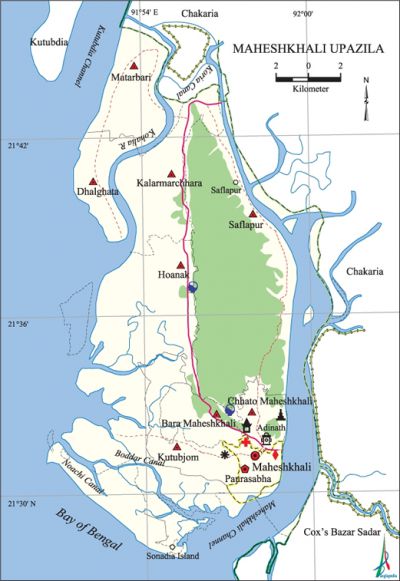Maheshkhali Upazila
Maheshkhali Upazila (cox’s Bazar district) area 362.18 sq km, located in between 21°28' and 21°46' north latitudes and in between 91°51' and 91°59' east longitudes. It is bounded by chakaria upazila on the north, cox’s bazar sadar upazila and bay of bengal on the south, Chakaria and Cox's Bazar Sadar upazilas on the east, kutubdia upazila and Bay of Bengal on the west.
Population Total 321218; male 165693, female 155525; Muslim 301858, Hindu 16647, Buddhist 2682, Christian 6 and others 25.
Water bodies Main rivers: Kohalia; Maheshkhali Channel, Boddar Canal, Noachi Canal, Koria Canal are notable.
'Administration Maheshkhali Thana was turned into an upazila on 15 December 1983.
| Upazila | ||||||||
| Municipality | Union | Mouza | Village | Population | Density (per sq km) | Literacy rate (%) | ||
| Urban | Rural | Urban | Rural | |||||
| 1 | 8 | 29 | 151 | 27321 | 293897 | 887 | 43.7 | 29.5 |
| Municipality | ||||||||
|
Area (sq km) |
Ward |
Mahalla |
Population |
Density (per sq km) |
Literacy rate (%) | |||
| 7.70 | 9 | 28 | 27321 | 3548 | 43.7 | |||
| Union | ||||
| Name of union and GO code | Area (acre) | Population | Literacy rate (%) | |
| Male | Female | |||
| Kalarmarchhara 59 | 7174 | 25615 | 23653 | 33.1 |
| Kutubjom 62 | 7527 | 15766 | 14871 | 25.7 |
| Chhota Maheshkhali 18 | 2722 | 13312 | 11943 | 22.9 |
| Dhalghata 23 | 494 | 6688 | 6189 | 31.7 |
| Bara Maheshkhali 11 | 3706 | 23466 | 21602 | 34.2 |
| Matarbari 71 | 6682 | 22801 | 22136 | 27.7 |
| Saflapur 83 | 34077 | 17461 | 16807 | 27.2 |
| Hoanak 47 | 9195 | 26515 | 25072 | 29.9 |
Source Bangladesh Population Census 2011, Bangladesh Bureau of Statistics.

Archaeological heritage and relics adinath temple (Mainak Hill, Gorakghata Union).
War of Liberation During the period of the War of Liberation, the Pakistan army and their local collaborators came to the upazila on 6 May 1971 and heavily tortured and killed many local people and also had burnt down the Buddhist monastery. They also carried out mass killings in 8-9 different places of the upazila including a village of the Rakhine community.
For details: see মহেশখালী উপজেলা, বাংলাদেশ মুক্তিযুদ্ধ জ্ঞানকোষ (Encyclopedia of Bangladesh War of Liberation), বাংলাদেশ এশিয়াটিক সোসাইটি, ঢাকা ২০২০, খণ্ড ৭।
Religious institutions Mosque 210, temple 26, buddhist keyang 6.
Literacy rate and educational institutions Average literacy 30.8%; male 30.5%, female 31.1%. Educational institutions: college 10, secondary school 33, primary school 70, kindergarten 12, madrasa 33. Noted educational institutions: Maheshkhali College (1985), Maheshkhali Government Vernacular School (1923), Maheshkhali Model High School (1946).
Newspapers and periodicals Maheshkhali Barta, Alor Dwip.
Cultural organisations Library 1, club 13.
Amusement centres or tourists spots Adinath Temple, Mainak Hill, Sonadia Island, keyang of the rakhain.
Main sources of income Agriculture 61.92%, non-agricultural labourer 7.26%, commerce 15.46%, transport and communication 1.49%, service 2.74%, construction 0.56%, religious service 0.20%, rent and remittance 0.45% and others 9.92%.
Ownership of agricultural land Landowner 33.23%, landless 66.77%; agricultural landowner: urban 20.93% and rural 33.94%.'
Extinct or nearly extinct crops Pearl production.
Main fruits Mango, jackfruit, litchi, banana, papaya, coconut.
Fisheries, dairies and poultries This upazila has a number of fisheries, dairies and poultries.
Communication facilities Pucca road 92.98 km, semi-pucca road 150 km, mud road 200 km; waterway 70 km.
Extinct or nearly extinct traditional transport Palanquin, horse carriage, bullock cart.
Noted manufactories Salt industry, fish processing industry, flour mill, ice mill.
Cottage industries Weaving, potteries, handicrafts.
Hats, bazars and fairs Hats and bazars are 15, fair 1, most noted of which are Gorakghata Bazar, Bara Maheshkhali Bazar, Kalarmarchhara Bazar, Time Bazar and Adinath Mela.
Main exports Salt, shrimp, sea-fish, dry fish.
Access to electricity All the wards and unions of the upazila are under rural electrification net-work. However 25.6% of the dwelling households have access to electricity.
Sources of drinking water Tube-well 89.5%, tap 0.4% and others 10.1%.
Sanitation 28.0% of dwelling households of the upazila use sanitary latrines and 52.1% of dwelling households use non-sanitary latrines; 19.9% of households do not have latrine facilities.
Health centres Upazila health complex 1, satellite clinic 1, union health and family planning centre 6, pathology' 4.
Natural disasters Many people were victims of the cyclone and tidal bore of 29 April 1991. It also caused heavy damages to settlements, livestock and other crops of the upazila.
NGO activities Operationally important NGOs are caritas, Christian Commission Development in Bangladesh, Prism Bangladesh. [Mohammad Jasim Uddin]
References Bangladesh Population Census 2001 and 2011, Bangladesh Bureau of Statistics; Cultural survey report of Maheshkhali Upazila 2007.
